P.E. PrepScale
Multi-scale structural similarity for image quality assesment
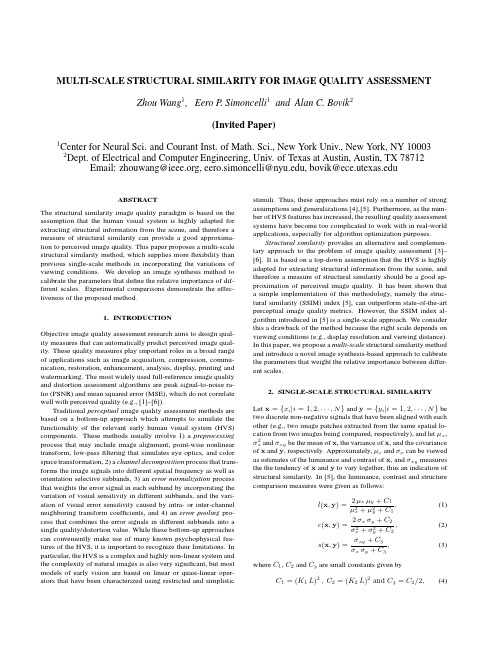
MULTI-SCALE STRUCTURAL SIMILARITY FOR IMAGE QUALITY ASSESSMENT Zhou Wang1,Eero P.Simoncelli1and Alan C.Bovik2(Invited Paper)1Center for Neural Sci.and Courant Inst.of Math.Sci.,New York Univ.,New York,NY10003 2Dept.of Electrical and Computer Engineering,Univ.of Texas at Austin,Austin,TX78712 Email:zhouwang@,eero.simoncelli@,bovik@ABSTRACTThe structural similarity image quality paradigm is based on the assumption that the human visual system is highly adapted for extracting structural information from the scene,and therefore a measure of structural similarity can provide a good approxima-tion to perceived image quality.This paper proposes a multi-scale structural similarity method,which supplies moreflexibility than previous single-scale methods in incorporating the variations of viewing conditions.We develop an image synthesis method to calibrate the parameters that define the relative importance of dif-ferent scales.Experimental comparisons demonstrate the effec-tiveness of the proposed method.1.INTRODUCTIONObjective image quality assessment research aims to design qual-ity measures that can automatically predict perceived image qual-ity.These quality measures play important roles in a broad range of applications such as image acquisition,compression,commu-nication,restoration,enhancement,analysis,display,printing and watermarking.The most widely used full-reference image quality and distortion assessment algorithms are peak signal-to-noise ra-tio(PSNR)and mean squared error(MSE),which do not correlate well with perceived quality(e.g.,[1]–[6]).Traditional perceptual image quality assessment methods are based on a bottom-up approach which attempts to simulate the functionality of the relevant early human visual system(HVS) components.These methods usually involve1)a preprocessing process that may include image alignment,point-wise nonlinear transform,low-passfiltering that simulates eye optics,and color space transformation,2)a channel decomposition process that trans-forms the image signals into different spatial frequency as well as orientation selective subbands,3)an error normalization process that weights the error signal in each subband by incorporating the variation of visual sensitivity in different subbands,and the vari-ation of visual error sensitivity caused by intra-or inter-channel neighboring transform coefficients,and4)an error pooling pro-cess that combines the error signals in different subbands into a single quality/distortion value.While these bottom-up approaches can conveniently make use of many known psychophysical fea-tures of the HVS,it is important to recognize their limitations.In particular,the HVS is a complex and highly non-linear system and the complexity of natural images is also very significant,but most models of early vision are based on linear or quasi-linear oper-ators that have been characterized using restricted and simplistic stimuli.Thus,these approaches must rely on a number of strong assumptions and generalizations[4],[5].Furthermore,as the num-ber of HVS features has increased,the resulting quality assessment systems have become too complicated to work with in real-world applications,especially for algorithm optimization purposes.Structural similarity provides an alternative and complemen-tary approach to the problem of image quality assessment[3]–[6].It is based on a top-down assumption that the HVS is highly adapted for extracting structural information from the scene,and therefore a measure of structural similarity should be a good ap-proximation of perceived image quality.It has been shown that a simple implementation of this methodology,namely the struc-tural similarity(SSIM)index[5],can outperform state-of-the-art perceptual image quality metrics.However,the SSIM index al-gorithm introduced in[5]is a single-scale approach.We consider this a drawback of the method because the right scale depends on viewing conditions(e.g.,display resolution and viewing distance). In this paper,we propose a multi-scale structural similarity method and introduce a novel image synthesis-based approach to calibrate the parameters that weight the relative importance between differ-ent scales.2.SINGLE-SCALE STRUCTURAL SIMILARITYLet x={x i|i=1,2,···,N}and y={y i|i=1,2,···,N}be two discrete non-negative signals that have been aligned with each other(e.g.,two image patches extracted from the same spatial lo-cation from two images being compared,respectively),and letµx,σ2x andσxy be the mean of x,the variance of x,and the covariance of x and y,respectively.Approximately,µx andσx can be viewed as estimates of the luminance and contrast of x,andσxy measures the the tendency of x and y to vary together,thus an indication of structural similarity.In[5],the luminance,contrast and structure comparison measures were given as follows:l(x,y)=2µxµy+C1µ2x+µ2y+C1,(1)c(x,y)=2σxσy+C2σ2x+σ2y+C2,(2)s(x,y)=σxy+C3σxσy+C3,(3) where C1,C2and C3are small constants given byC1=(K1L)2,C2=(K2L)2and C3=C2/2,(4)Fig.1.Multi-scale structural similarity measurement system.L:low-passfiltering;2↓:downsampling by2. respectively.L is the dynamic range of the pixel values(L=255for8bits/pixel gray scale images),and K1 1and K2 1aretwo scalar constants.The general form of the Structural SIMilarity(SSIM)index between signal x and y is defined as:SSIM(x,y)=[l(x,y)]α·[c(x,y)]β·[s(x,y)]γ,(5)whereα,βandγare parameters to define the relative importanceof the three components.Specifically,we setα=β=γ=1,andthe resulting SSIM index is given bySSIM(x,y)=(2µxµy+C1)(2σxy+C2)(µ2x+µ2y+C1)(σ2x+σ2y+C2),(6)which satisfies the following conditions:1.symmetry:SSIM(x,y)=SSIM(y,x);2.boundedness:SSIM(x,y)≤1;3.unique maximum:SSIM(x,y)=1if and only if x=y.The universal image quality index proposed in[3]corresponds to the case of C1=C2=0,therefore is a special case of(6).The drawback of such a parameter setting is that when the denominator of Eq.(6)is close to0,the resulting measurement becomes unsta-ble.This problem has been solved successfully in[5]by adding the two small constants C1and C2(calculated by setting K1=0.01 and K2=0.03,respectively,in Eq.(4)).We apply the SSIM indexing algorithm for image quality as-sessment using a sliding window approach.The window moves pixel-by-pixel across the whole image space.At each step,the SSIM index is calculated within the local window.If one of the image being compared is considered to have perfect quality,then the resulting SSIM index map can be viewed as the quality map of the other(distorted)image.Instead of using an8×8square window as in[3],a smooth windowing approach is used for local statistics to avoid“blocking artifacts”in the quality map[5].Fi-nally,a mean SSIM index of the quality map is used to evaluate the overall image quality.3.MULTI-SCALE STRUCTURAL SIMILARITY3.1.Multi-scale SSIM indexThe perceivability of image details depends the sampling density of the image signal,the distance from the image plane to the ob-server,and the perceptual capability of the observer’s visual sys-tem.In practice,the subjective evaluation of a given image varies when these factors vary.A single-scale method as described in the previous section may be appropriate only for specific settings.Multi-scale method is a convenient way to incorporate image de-tails at different resolutions.We propose a multi-scale SSIM method for image quality as-sessment whose system diagram is illustrated in Fig. 1.Taking the reference and distorted image signals as the input,the system iteratively applies a low-passfilter and downsamples thefiltered image by a factor of2.We index the original image as Scale1, and the highest scale as Scale M,which is obtained after M−1 iterations.At the j-th scale,the contrast comparison(2)and the structure comparison(3)are calculated and denoted as c j(x,y) and s j(x,y),respectively.The luminance comparison(1)is com-puted only at Scale M and is denoted as l M(x,y).The overall SSIM evaluation is obtained by combining the measurement at dif-ferent scales usingSSIM(x,y)=[l M(x,y)]αM·Mj=1[c j(x,y)]βj[s j(x,y)]γj.(7)Similar to(5),the exponentsαM,βj andγj are used to ad-just the relative importance of different components.This multi-scale SSIM index definition satisfies the three conditions given in the last section.It also includes the single-scale method as a spe-cial case.In particular,a single-scale implementation for Scale M applies the iterativefiltering and downsampling procedure up to Scale M and only the exponentsαM,βM andγM are given non-zero values.To simplify parameter selection,we letαj=βj=γj forall j’s.In addition,we normalize the cross-scale settings such thatMj=1γj=1.This makes different parameter settings(including all single-scale and multi-scale settings)comparable.The remain-ing job is to determine the relative values across different scales. Conceptually,this should be related to the contrast sensitivity func-tion(CSF)of the HVS[7],which states that the human visual sen-sitivity peaks at middle frequencies(around4cycles per degree of visual angle)and decreases along both high-and low-frequency directions.However,CSF cannot be directly used to derive the parameters in our system because it is typically measured at the visibility threshold level using simplified stimuli(sinusoids),but our purpose is to compare the quality of complex structured im-ages at visible distortion levels.3.2.Cross-scale calibrationWe use an image synthesis approach to calibrate the relative impor-tance of different scales.In previous work,the idea of synthesizing images for subjective testing has been employed by the“synthesis-by-analysis”methods of assessing statistical texture models,inwhich the model is used to generate a texture with statistics match-ing an original texture,and a human subject then judges the sim-ilarity of the two textures [8]–[11].A similar approach has also been qualitatively used in demonstrating quality metrics in [5],[12],though quantitative subjective tests were not conducted.These synthesis methods provide a powerful and efficient means of test-ing a model,and have the added benefit that the resulting images suggest improvements that might be made to the model[11].M )distortion level (MSE)12345Fig.2.Demonstration of image synthesis approach for cross-scale calibration.Images in the same row have the same MSE.Images in the same column have distortions only in one specific scale.Each subject was asked to select a set of images (one from each scale),having equal quality.As an example,one subject chose the marked images.For a given original 8bits/pixel gray scale test image,we syn-thesize a table of distorted images (as exemplified by Fig.2),where each entry in the table is an image that is associated witha specific distortion level (defined by MSE)and a specific scale.Each of the distorted image is created using an iterative procedure,where the initial image is generated by randomly adding white Gaussian noise to the original image and the iterative process em-ploys a constrained gradient descent algorithm to search for the worst images in terms of SSIM measure while constraining MSE to be fixed and restricting the distortions to occur only in the spec-ified scale.We use 5scales and 12distortion levels (range from 23to 214)in our experiment,resulting in a total of 60images,as demonstrated in Fig.2.Although the images at each row has the same MSE with respect to the original image,their visual quality is significantly different.Thus the distortions at different scales are of very different importance in terms of perceived image quality.We employ 10original 64×64images with different types of con-tent (human faces,natural scenes,plants,man-made objects,etc.)in our experiment to create 10sets of distorted images (a total of 600distorted images).We gathered data for 8subjects,including one of the authors.The other subjects have general knowledge of human vision but did not know the detailed purpose of the study.Each subject was shown the 10sets of test images,one set at a time.The viewing dis-tance was fixed to 32pixels per degree of visual angle.The subject was asked to compare the quality of the images across scales and detect one image from each of the five scales (shown as columns in Fig.2)that the subject believes having the same quality.For example,one subject chose the images marked in Fig.2to have equal quality.The positions of the selected images in each scale were recorded and averaged over all test images and all subjects.In general,the subjects agreed with each other on each image more than they agreed with themselves across different images.These test results were normalized (sum to one)and used to calculate the exponents in Eq.(7).The resulting parameters we obtained are β1=γ1=0.0448,β2=γ2=0.2856,β3=γ3=0.3001,β4=γ4=0.2363,and α5=β5=γ5=0.1333,respectively.4.TEST RESULTSWe test a number of image quality assessment algorithms using the LIVE database (available at [13]),which includes 344JPEG and JPEG2000compressed images (typically 768×512or similar size).The bit rate ranges from 0.028to 3.150bits/pixel,which allows the test images to cover a wide quality range,from in-distinguishable from the original image to highly distorted.The mean opinion score (MOS)of each image is obtained by averag-ing 13∼25subjective scores given by a group of human observers.Eight image quality assessment models are being compared,in-cluding PSNR,the Sarnoff model (JNDmetrix 8.0[14]),single-scale SSIM index with M equals 1to 5,and the proposed multi-scale SSIM index approach.The scatter plots of MOS versus model predictions are shown in Fig.3,where each point represents one test image,with its vertical and horizontal axes representing its MOS and the given objective quality score,respectively.To provide quantitative per-formance evaluation,we use the logistic function adopted in the video quality experts group (VQEG)Phase I FR-TV test [15]to provide a non-linear mapping between the objective and subjective scores.After the non-linear mapping,the linear correlation coef-ficient (CC),the mean absolute error (MAE),and the root mean squared error (RMS)between the subjective and objective scores are calculated as measures of prediction accuracy .The prediction consistency is quantified using the outlier ratio (OR),which is de-Table1.Performance comparison of image quality assessment models on LIVE JPEG/JPEG2000database[13].SS-SSIM: single-scale SSIM;MS-SSIM:multi-scale SSIM;CC:non-linear regression correlation coefficient;ROCC:Spearman rank-order correlation coefficient;MAE:mean absolute error;RMS:root mean squared error;OR:outlier ratio.Model CC ROCC MAE RMS OR(%)PSNR0.9050.901 6.538.4515.7Sarnoff0.9560.947 4.66 5.81 3.20 SS-SSIM(M=1)0.9490.945 4.96 6.25 6.98 SS-SSIM(M=2)0.9630.959 4.21 5.38 2.62 SS-SSIM(M=3)0.9580.956 4.53 5.67 2.91 SS-SSIM(M=4)0.9480.946 4.99 6.31 5.81 SS-SSIM(M=5)0.9380.936 5.55 6.887.85 MS-SSIM0.9690.966 3.86 4.91 1.16fined as the percentage of the number of predictions outside the range of±2times of the standard deviations.Finally,the predic-tion monotonicity is measured using the Spearman rank-order cor-relation coefficient(ROCC).Readers can refer to[15]for a more detailed descriptions of these measures.The evaluation results for all the models being compared are given in Table1.From both the scatter plots and the quantitative evaluation re-sults,we see that the performance of single-scale SSIM model varies with scales and the best performance is given by the case of M=2.It can also be observed that the single-scale model tends to supply higher scores with the increase of scales.This is not surprising because image coding techniques such as JPEG and JPEG2000usually compressfine-scale details to a much higher degree than coarse-scale structures,and thus the distorted image “looks”more similar to the original image if evaluated at larger scales.Finally,for every one of the objective evaluation criteria, multi-scale SSIM model outperforms all the other models,includ-ing the best single-scale SSIM model,suggesting a meaningful balance between scales.5.DISCUSSIONSWe propose a multi-scale structural similarity approach for image quality assessment,which provides moreflexibility than single-scale approach in incorporating the variations of image resolution and viewing conditions.Experiments show that with an appropri-ate parameter settings,the multi-scale method outperforms the best single-scale SSIM model as well as state-of-the-art image quality metrics.In the development of top-down image quality models(such as structural similarity based algorithms),one of the most challeng-ing problems is to calibrate the model parameters,which are rather “abstract”and cannot be directly derived from simple-stimulus subjective experiments as in the bottom-up models.In this pa-per,we used an image synthesis approach to calibrate the param-eters that define the relative importance between scales.The im-provement from single-scale to multi-scale methods observed in our tests suggests the usefulness of this novel approach.However, this approach is still rather crude.We are working on developing it into a more systematic approach that can potentially be employed in a much broader range of applications.6.REFERENCES[1] A.M.Eskicioglu and P.S.Fisher,“Image quality mea-sures and their performance,”IEEE munications, vol.43,pp.2959–2965,Dec.1995.[2]T.N.Pappas and R.J.Safranek,“Perceptual criteria for im-age quality evaluation,”in Handbook of Image and Video Proc.(A.Bovik,ed.),Academic Press,2000.[3]Z.Wang and A.C.Bovik,“A universal image quality in-dex,”IEEE Signal Processing Letters,vol.9,pp.81–84,Mar.2002.[4]Z.Wang,H.R.Sheikh,and A.C.Bovik,“Objective videoquality assessment,”in The Handbook of Video Databases: Design and Applications(B.Furht and O.Marques,eds.), pp.1041–1078,CRC Press,Sept.2003.[5]Z.Wang,A.C.Bovik,H.R.Sheikh,and E.P.Simon-celli,“Image quality assessment:From error measurement to structural similarity,”IEEE Trans.Image Processing,vol.13, Jan.2004.[6]Z.Wang,L.Lu,and A.C.Bovik,“Video quality assessmentbased on structural distortion measurement,”Signal Process-ing:Image Communication,special issue on objective video quality metrics,vol.19,Jan.2004.[7] B.A.Wandell,Foundations of Vision.Sinauer Associates,Inc.,1995.[8]O.D.Faugeras and W.K.Pratt,“Decorrelation methods oftexture feature extraction,”IEEE Pat.Anal.Mach.Intell., vol.2,no.4,pp.323–332,1980.[9] A.Gagalowicz,“A new method for texturefields synthesis:Some applications to the study of human vision,”IEEE Pat.Anal.Mach.Intell.,vol.3,no.5,pp.520–533,1981. [10] D.Heeger and J.Bergen,“Pyramid-based texture analy-sis/synthesis,”in Proc.ACM SIGGRAPH,pp.229–238,As-sociation for Computing Machinery,August1995.[11]J.Portilla and E.P.Simoncelli,“A parametric texture modelbased on joint statistics of complex wavelet coefficients,”Int’l J Computer Vision,vol.40,pp.49–71,Dec2000. [12]P.C.Teo and D.J.Heeger,“Perceptual image distortion,”inProc.SPIE,vol.2179,pp.127–141,1994.[13]H.R.Sheikh,Z.Wang, A. C.Bovik,and L.K.Cormack,“Image and video quality assessment re-search at LIVE,”/ research/quality/.[14]Sarnoff Corporation,“JNDmetrix Technology,”http:///products_services/video_vision/jndmetrix/.[15]VQEG,“Final report from the video quality experts groupon the validation of objective models of video quality assess-ment,”Mar.2000./.PSNRM O SSarnoffM O S(a)(b)Single−scale SSIM (M=1)M O SSingle−scale SSIM (M=2)M O S(c)(d)Single−scale SSIM (M=3)M O SSingle−scale SSIM (M=4)M O S(e)(f)Single−scale SSIM (M=5)M O SMulti−scale SSIMM O S(g)(h)Fig.3.Scatter plots of MOS versus model predictions.Each sample point represents one test image in the LIVE JPEG/JPEG2000image database [13].(a)PSNR;(b)Sarnoff model;(c)-(g)single-scale SSIM method for M =1,2,3,4and 5,respectively;(h)multi-scale SSIM method.。
自注意力计算流程中的scale的作用
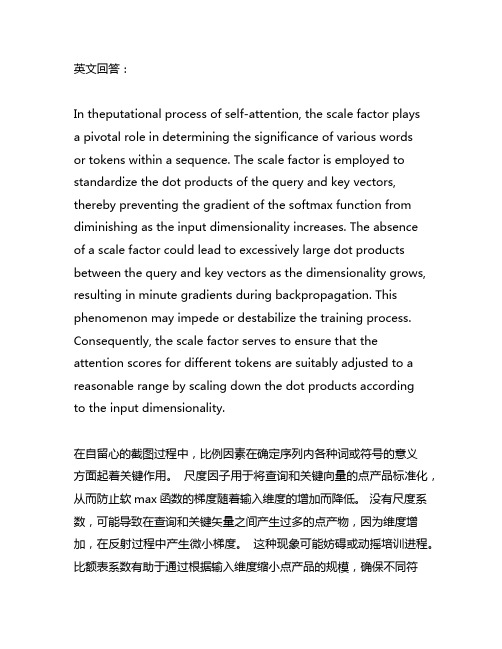
英文回答:In theputational process of self-attention, the scale factor playsa pivotal role in determining the significance of various wordsor tokens within a sequence. The scale factor is employed to standardize the dot products of the query and key vectors, thereby preventing the gradient of the softmax function from diminishing as the input dimensionality increases. The absenceof a scale factor could lead to excessively large dot products between the query and key vectors as the dimensionality grows, resulting in minute gradients during backpropagation. This phenomenon may impede or destabilize the training process. Consequently, the scale factor serves to ensure that the attention scores for different tokens are suitably adjusted to a reasonable range by scaling down the dot products accordingto the input dimensionality.在自留心的截图过程中,比例因素在确定序列内各种词或符号的意义方面起着关键作用。
语言学专业词汇

AAcS (actor Subject), ReS (Receptor Subject) and DaS (dative vesubject) P85Active deposit 活性沉积P393adaptability制宜原则P39adjustment 调整P135AdjMr:Ajective Modifier 定语修饰语P19Affixing morpheme of fixed position 定位性附加语素P342Affixation 缀合法P29All encompassing 无所不包P ixAphasic 失语症患者P386ApoP 同位短语式P188Approximative system 近似体系P58arbitrariness任意性; selectiveness 选择性P181Aspect 体(tentative尝试体, inchoative开始体, successive继续体, perfect完成体, progressive 进行体)P114Autonomy 自主权P53Bbackshift后移P370/372bilingualism 双语学P522Blending 拼缀法P29Bottom-up perception自下而上的感知,top-down perception自上而下的感知P493CCart Fames1980 对比分析P xcirculativeness 周遍性P86categorization范畴化, grouping 归为类P487category word 范畴词P418/474/513cleft sentence 分裂句P230cognate equivalence同源对应P134/468,词根对应P478cognitive schema认知图示P386Cohesion 粘着性P62Cohesion and coherence接应与连贯P74Cohesive tie 联结关系接应词,additive 增补连接词,adversative 对比连接词,causal conjunction因果连接词,temporal conjunction 时间连接词P436Combination (虚词功能)组合P452Total combination完全结合,formal combination形式结合P464Common value (语言)共同价值;special value 特征价值P47Complement 补语P126Composition 合成法P29Compactness of meaningful morpheme有义语素结合紧密度P299Compressed predicate 紧缩式谓语P120Compound (汉语)合成词P443Conversion 转化法P29Constant 常数(ie. tertium comparationis中间比较项);variable变数;tertium 中间项P50Context-sensitive rule 受上下文制约的规则P362Convertness and overtness 隐含性与外显性P61Copula 系词;copulative object 判断宾语;quasi-copulas 准判断动词P217Coverb 前置动词(能愿、意向、规劝动词)和后置动词的统称;operator基本助动词/功能词P114DDative case与事格P159defiguration还原法, figuration 形象描写P472Description and Prescription 描写与规定P41descriptive approach描写态度P39determinative premodifier 限制性前置定语,descriptive premodifier 描绘性前置定语,classifying premodifier 分类性前置定语P298Diachronic and synchronic/ diachronism and synchronism 历时与共时P2Diachronic experience and synchronic performance 历时经验和共时运用P314Dichotomic 二分性,可切分为二P167Differentiating ability 分辨力P361Diffuse 扩散型;compact聚集型P235Directness 直接性,indirectness间接性,explic itness鲜明性, specificness重实,non-specificness反虚P417Disintegration 解体P28dismantle拆除P28Disorganization 瓦解P28Disposal form动词处置式(把字句) P213; pre-transitive V erb 前及物动词(赵元任:把字句)P233 Diversiform 多样性P85Divide 长句切分;contract 长句紧缩P208Doer and receptor 行为者与承受者P89Doublet/ word pair谐音叠词P426EEnd-focus 短语后焦点;front-focus 弱化前焦点P175End-weight词尾重心P229Epicene通性名词P82Equivalence 对应P58evolution演进P28Explanation 解释; Interpretation 阐释P41Explication 演绎法P469Expletive 先行词P74Expletive subject 形式主语P92FFamily resemblances 维根斯坦:家族相似;Dissimililarilies 非相似性PvFinite verb 定式动词;non-finite verb 非定式动词P236Formal or inflexional linkage 形式或形态对接P26Formal indication 形式的标定P62-3Frame of word词语联立关系P466Functional compensation 功能互补P154Functional expansion 功能扩大化P191Functional redress, functional compensation 功能代偿法P33Function test 话题性的测试P90Functional word (form word, structural word) 结构词(英语),empty word虚词(汉语), P449 closed classes 封闭性词类,P449determiner 限定词,auxiliary助动词,pronoun代词,P449,preposition介词,qualifier 修饰词,coordinator 并列连接词,subordinator 从属连接词,interrogative 疑问词,negative 否定词P450full word 实词(汉语)P450GGiven-new contract已知-新知信息默契P372HHead word 中心词P296Heterology 异质性/特殊素质P95/202HW:head word中心词P19Hypotaxis and parataxis 形合与意合P75IIcon 图像性,iconization图像化, indexization索引化P455identity等同(是字句功能)P219Ideographicand semipronouncing 单体形意音文字P viIdeational pvotal, idea-centered 意念主轴;formal-pivotal, formal-centered 形式主轴P18idea-centered structure意念主轴结构;formal-centered structure形式主轴结构P18idiom 成语/习语;a single unit一个单位P166image code 象码;Souund code音码P68immediate constituent analysis 直接成分分析法P232impersonal subject非人称主语P498implication 暗示法P22Inbreak of the modernity 葛兆光:现代性入侵P ivIndicator 指示器P47indispensability不可或缺性P47infiltration 渗透性,intrinsicness固有性,peculiarity特性P476Inflectional devices 无形态程式P viiiInflexional formation 形态构性P453Inflexional system 形态体系P52Inflexionalization 形态化P154Inner speech 内部言语,speech 外部言语P387Intentional word意向词语P163intensifier加强词P378Interlingua 中介语P58Interlingual comparability 语际可比性P51Interpretation 解释法P22Intraflexion 内部屈折P396Introducer 引导性结构P302JJohn Stuart Mill 1806-1873 功利追求P xJuxtaposing 联合短语式P183KKernel (句法结构) 核心P84Kinship 与原亲属关系P468Llanguage game 语言游戏P39Latin Grammar马建忠:泰西格朗玛PvLexicalization 词汇化P312,inflexion 形态化P368Linearization对接;formation成型;aggregation聚集P69Linguistic determinism语言决定论,language relativity语言相对论P525LocWP 方位短语式P187LR (linear reverse???) 顺序线性P62;RL (reversed linear) 逆线性P69MMapping 映射P68/371/492Masculine 阳性P397Matching 配对P52Maximized implicitness 最大化隐含;information focus信息焦点P191mean中数;overlap语义场界重叠;outlap非重叠P183means of generalization实义虚化手段,affixational means词缀虚化手段P446,inflexional means 形态虚化手段P447, specified 实化P449Misplacement and breach 错位和缺位P ixMissing link 缺环P518MnS(Means Subject) 方式主语P102Mode of expression表现法,relativity相关性,instrumentality实用性,generality通用性P391 Moderate adaptation 适度的适应,adaptationby通过adjustment调整来适应P429Mood 语气,indicative mood直陈式, imperative mood祈使式, subjunctive mood虚拟式, Intrinsic and extrinsic 内在和外在语言结构机制,factualsupposition事实假设, counterfactual supposition 反事实假设deficit 欠缺的观点P369morpheme for morpheme义素对义素P468Mr-Md (modifier-modified) 修饰语前置式,偏正词组;Md-Mr (modified-modifier);hyphenated adjectives 连字符连接的多词形容词P167MrS(Modifier Subject)修饰语主语P102Mutual compensatory 互为补充代偿P308NN.Machiavelli 1459-1527 马基尔维利,15世纪‘欧洲最著名政论、史论家之一P iv Nominal 名词性P91Nominal phrase名词性短语P188Nominative 主格,genitive 所有格,dative 与格,accusative 宾格P396Non-SP sentence非主谓句P203nucleus(语音)调核P304OOnomatopoeia 象声,拟声P5Open beginning 句首开放性;contracting ending/closed ending 句尾收缩性P205Operating and orientating mechanism 支配与定势作用P487Operator 功能词P118Ordering 序列P70Orientation 导向P391Outwardness 外象(包括:表象、形象、现象、物象)P26PPattern (形态体系的)结构形式P396pair成对词P184Paradox 悖理P182PC of extend/ degree表程度的述补结构P131PC of movement 表行为态势活动向的述补结构:direction趋向;progress继续;completion 完成P128PC of possibility表可能的述补结构P128PC of result表结果的述补结构P129PC of state表状态的述补结构P130Pejoration 贬义化Perceptive language 感性语言P xPeriodic sentence 掉尾句P310Phonograph 表音文字P418Phonetic morpheme 语义语素,form morpheme 构形语素,reduplication morpheme复叠语素,full morpheme 完全语素P460/461Phrasal verb and particle 短语动词与小品词/介副词P??/154pictograph/ hieroglyph 象形文字P2pivot/axle主轴P236PlS (Place Subject) P86Polar contrast 正反两面合二为一的复合词P473Polarization 两极化P87Pragmatic motivation语用理据P175Pragmatic presupposition 语用预设P164Predicate-complete construction述补结构P128predication谓词性;sub-predication次谓词性P189Predicative phrase 谓词性短语P188PrepOP 介词短语式P187Pre-position coverb 前置助动词P377Principle of cause and result sequence 因果律P299Principle of compactness of meaningful morpheme 语素结合紧密度律P299Principle of exterior-interior sequence 表里律P296Principle of spatial sequence 范围律P294Principle of subject-object sequence 主客律P295Principle of temporal sequence 时序律P291Principles of SV concord 主谓一致原则: Grammatical principle 语法原则, Logical principle逻辑原则, Principle of Proximity 靠近原则, Principle of Idiomaticness 惯用法原则P115 Presupposed statement and concluding statement, PS and CS 前述与结述P57/309QQrQd (qualifier-qualified) 附加式P202QunWP 量词短语式P188Rrecipiency受事性;recipiency 施授关系;affection 受到影响的关系P158Redress/ compensation (语法功能的)代偿法P22Reduplication(构词法)重叠法,adjunction附加法,affixation加缀法,compound 合成法P444-445Refinement 提炼;Gradation 提升P41Relative comparability 相对可比性P51Reflective 反映式的,折射式的P456equivalence对应式(correspondence契合式),inclusion涵盖式P457,intersection 交叉式P458,substitution替代式,conflict 冲突式(exclusion 语义相悖) P459 kinship term P457,borrowing借用P459reflection 反映P496relativity 相关性,instrumentality实用性,generality通用性,familiarization通晓性P392 Repetition 重叠手段,anaphora句首反复,epiphora句尾反复P427Reversed Linear Expansion逆线性延伸;Natural Linear Expansion顺线性延伸P205 reversibility 可反逆性P174/276reversion 对接的反转P464reversing and synchronizing 顺译与反逆翻译P105R.Philippson 2002: 英语帝国主义PvRunning sentence 流水句P235SSA V P62Selective and critica 选择性和批判性P xSemantic combination 语义结合,grammatical combination 语法结合P441Semantic relevance 语义关涉性P181Semantic structuring 语义结构过程,form structuring 形式结构过程P387Sense morpheme义素,meaningful morpheme有义语素,free morpheme自由语素,boundmorpheme黏着语素P441Sentence starter句首起词P110/503Sequence 顺序,inverse/reverse 抵触逆序,mixed order混合序P409Shift 转换P100Shortening 缩略法P29Sign language手语P386Signifying 意指; analogizing类比P47Situationally defined语境化P479Space between words词间距P80Staccato 断续P421Stratification 层次结构P232Stress domain 重音范域P75Stressed position 强调位P279Structural analogy 结构类比P81Structural inversion 结构性倒装functional inversion 功能性倒装stylistic inversion文体性倒装P277Structural order-shift 结构性位移P279Structural word 结构性词语,substantial word 实质性词语,presupposed information 预知性信息,replenished information 补足性信息,base挤出前述,climax递进叙述P305 StrWP 助词短语式P188SV concord/agreement 主谓一致P88/115SV Device主语-谓动机制P88SVOC P61subcategorization(语义特征)次范畴化(转换生成语法)P368Substitution替代法P22Sub-subject次主语P95Supplement 补充P106Syntagmatic device组合手段P404Syntagmatic ordering of element 组合型序列P275Syntagmatic pivot 形态组合主轴P237;paradigmatic pivot 意念聚合主轴P239TTautology 重复, sysmetry对仗P424TDC Expansion (topic-development-coda expansion) 命题-发展-结语语段扩展P257 Temporal sequence时序律P121Temps opératif (G. Guillaume)活动时间, system de representation 反应系统,system d’expression 观念P387Tense 语法的“时”,time自然概念的“时间”P340, tense particle 时态助词P342Tensity 紧张感,importunity 短促感,monotonounsness单调感P424Text 语段;logical expansion 逻辑扩展式;basic level 基础层级;logical level逻辑层级P234 Thematic 主位性P284/ 句首主题P315Thematization主题化,thematic fronting 宾语主题前置,topicality 话题性P316The relative 关系语P86TmS(time subject)P85Topic, theme, 话题(主语句)comment, rheme 述题P37-38Topic subject 话题主语P92transfer 迁移P522Transferability 可转换性P386Transformation 转型P28 转换式P214TR device 话题-述题机制P88typological 类型学体系P60VV alence/valency价(可以带什么宾语)P152/154V ertical 历时比较;horizontal共时比较P49Visual differentiation 视觉分辨率P404Visual recognizibility 视觉可辨性P449V ocalicending元音字尾P425voice in covertness 隐性语态P313, inflictive voice 不幸语态P318 volitional future 强于是将来时(表意志等)P453WWalter Benjamin; historical duress, geschichtlich Zwang: 历史的裹挟P xiZZero 零位P87ZeS-VP 零位主语结构P106。
ANSYS建模一般步骤
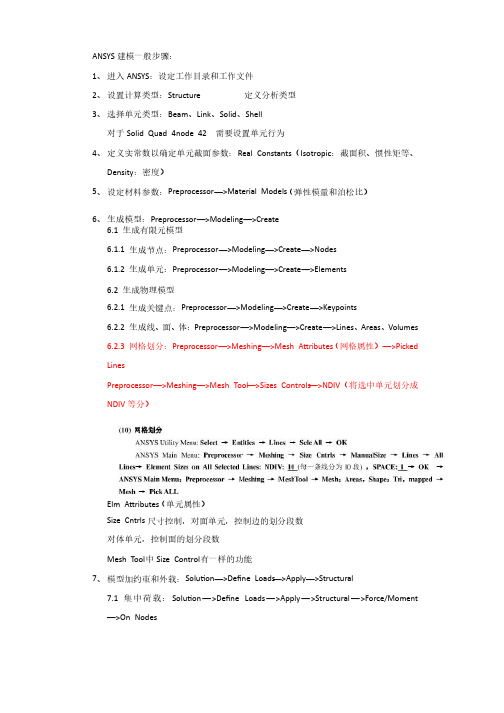
ANSYS 建模一般步骤:1、进入ANSYS :设定工作目录和工作文件2、设置计算类型:Structure 定义分析类型3、选择单元类型:Beam 、Link 、Solid 、Shell 对于Solid Quad 4node Solid Quad 4node 42 42 需要设置单元行为4、定义实常数以确定单元截面参数:Real Real Constants Constants (Isotropic :截面积、惯性矩等、Density :密度)5、设定材料参数:Preprocessor —>Material Models (弹性模量和泊松比)6、生成模型:Preprocessor —>Modeling —>Create 6.1 生成有限元模型6.1.1 生成节点:Preprocessor —>Modeling —>Create —>Nodes 6.1.2 生成单元:Preprocessor —>Modeling —>Create —>Elements 6.2 生成物理模型6.2.1 生成关键点:Preprocessor —>Modeling —>Create —>Keypoints 6.2.2 生成线、面、体:Preprocessor —>Modeling —>Create —>Lines 、Areas 、Volumes 6.2.3 网格划分:Preprocessor —>Meshing —>Mesh A ributes (网格属性)—>Picked Lines Preprocessor —>Meshing —>Mesh Tool —>Sizes Controls —>NDIV (将选中单元划分成NDIV 等分)Elm A ributes (单元属性)Size Cntrls 尺寸控制,对面单元,控制边的划分段数对体单元,控制面的划分段数Mesh Tool 中Size Control 有一样的功能7、模型加约束和外载:Solu on —>Define Loads —>Apply —>Structural 7.1 集中荷载:Solu on —>Define Loads —>Apply —>Structural —>Force/Moment —>On Nodes Loads—>Apply—>Structural—>Pressure—>On >Define Loads7.2 均布荷载:Solu on—>Define Beams 7.3 约束:Solu on—>Define Loads—>Apply—>Structural—>Displacement—>On Nodes 8、分析计算:Solu on—>Solve—>Current LS 9、结果显示:General Postproc(后处理)—>Plot Results(绘制结果)—>Deformed Shape(变形形状)(变形形状)General Postproc—>Plot Results—>Contour Plot(轮廓绘制)—>Nodal Solu(显示位移)—> Y-Component of displacement:显示:显示Y方向位移UY X-Component of displacement:显示X方向位移UX Element Table—>Define Table 。
丽讯D5系列投影仪说明书
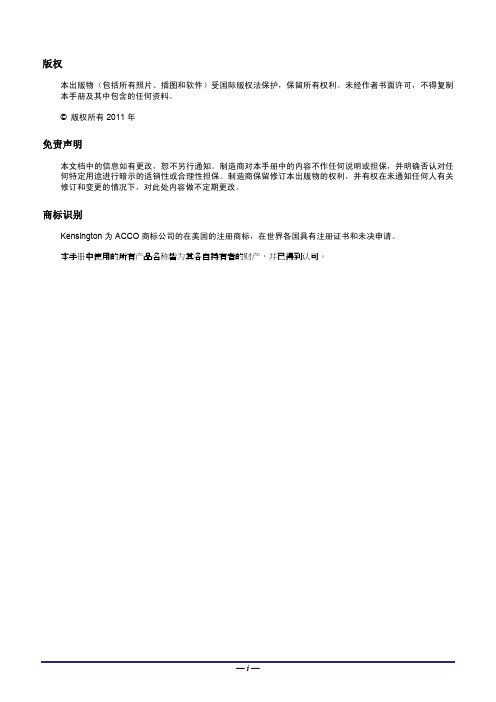
3H
86H
投影机部件图 .................................................................................................................................................................... 2
17H
10H
调节缩放、焦距和梯形校正........................................................................................................................................... 16
18H
10H
调节音量 .......................................................................................................................................................................... 17
8H
91H
遥控器部件 ........................................................................................................................................................................ 6
9H
92H
遥控器操作范围 ................................................................................................................................................................ 8
轴承专业英语大全
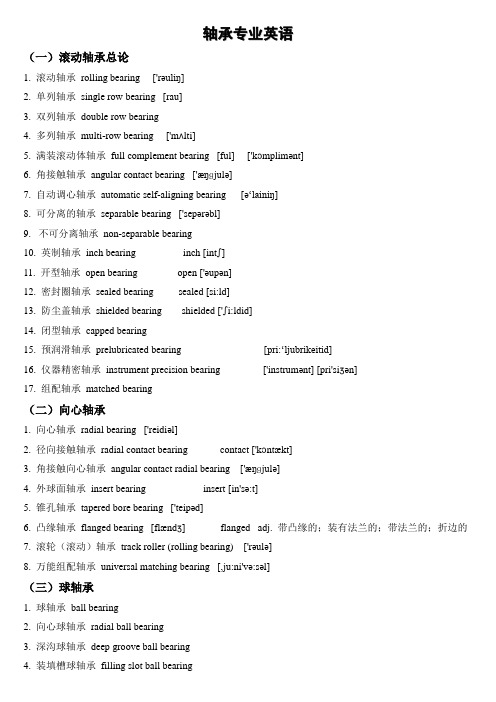
轴承专业英语(一)滚动轴承总论1. 滚动轴承rolling bearing ['rəuliŋ]2. 单列轴承single row bearing [rau]3. 双列轴承double row bearing4. 多列轴承multi-row bearing ['mʌlti]5. 满装滚动体轴承full complement bearing [ful] ['kɔmplimənt]6. 角接触轴承angular contact bearing ['æŋɡjulə]7. 自动调心轴承automatic self-aligning bearing [ə‘lainiŋ]8. 可分离的轴承separable bearing ['sepərəbl]9. 不可分离轴承non-separable bearing10. 英制轴承inch bearing inch [intʃ]11. 开型轴承open bearing open ['əupən]12. 密封圈轴承sealed bearing sealed [si:ld]13. 防尘盖轴承shielded bearing shielded ['ʃi:ldid]14. 闭型轴承capped bearing15. 预润滑轴承prelubricated bearing [pri:‘ljubrikeitid]16. 仪器精密轴承instrument precision bearing ['instrumənt] [pri'siʒən]17. 组配轴承matched bearing(二)向心轴承1. 向心轴承radial bearing ['reidiəl]2. 径向接触轴承radial contact bearing contact ['kɔntækt]3. 角接触向心轴承angular contact radial bearing ['æŋɡjulə]4. 外球面轴承insert bearing insert [in'sə:t]5. 锥孔轴承tapered bore bearing ['teipəd]6. 凸缘轴承flanged bearing [flændʒ] flanged adj. 带凸缘的;装有法兰的;带法兰的;折边的7. 滚轮(滚动)轴承track roller (rolling bearing) ['rəulə]8. 万能组配轴承universal matching bearing [,ju:ni'və:səl](三)球轴承1. 球轴承ball bearing2. 向心球轴承radial ball bearing3. 深沟球轴承deep groove ball bearing4. 装填槽球轴承filling slot ball bearing5. 三点接触球轴承three point contact ball bearing6. 四点接触球轴承four point contact ball bearing7. 推力球轴承thrust ball bearing8. 单列双向推力球轴承single row double-direction thrust ball bearing9. 双排单向推力球轴承doubel row single-direction thrust ball bearing10. 特种轴承special bearing11. 带止动环球轴承ball bearing with snap ring12. 外球面体球轴承external sphere ball bearing(四)轴承零件1. 轴承零件bearing part [pɑ:t]2. 轴承套圈bearing ring [riŋ]3. 轴承垫圈bearing washer4. 止动环snap ring [snæp] [riŋ]5. 隔圈spacer ['speisə]6. 密封圈seal [si:l]7.防尘盖shield8. 挡圈slinger ['sliŋə]9. 滚动体rolling element ['rəuliŋ]['elimənt]10. 保持架cage or retainer [ri'teinə]11. 内圈inner ring ['inə]12. 外圈outer ring ['autə]13. 油脂grease [ɡri:s]14. 钢球steel ball steel [sti:l] : 钢,钢的15. 偏心套eccentric collar [ik'sentrik]16. 锁紧套locking collar17. 止动销钉anti-rotation pin [pin]18. 轴承座housing ['hauziŋ]19. 橡胶套rubber grommet ['ɡromit]20. 紧定衬套adapter sleeve [ə'dæptə(r)] [sli:v]21、尺寸:dimension [di'menʃən]22、直径:diameter [dai'æmitə]23、宽度:width [widθ, witθ]24、长度:length [l eŋθ]25、高度:height [hait]26、角度:angle ['æŋɡl]27、半径:radius ['reidiəs]28、厚度:thickness ['θiknis]29、轴向的:axial ['æksiəl]30、径向的:radial ['reidjəl]31、外圆(外径)outside surface32、内圆(内径)inner surface33、沟道raceway(五)技术常用词1、公差:tolerance ['tɔlərəns] n. 公差;容忍;宽容;公差2、游隙:clearance ['kliərəns] 清除;清理;出清,出空【机械】余隙,间隙3、噪音:noise [nɔiz] n. 响声;杂音;噪音4、扭矩:torque [tɔ:k] n. 转矩,扭矩;项圈,金属领圈5、硬度:hardness ['hɑ:dnis] n. 硬度;坚硬;困难;冷酷6、倒角: chamfer ['tʃæmfə] vt. 去角;挖槽;斜切 n. 斜面;凹槽7、精度:precision [pri'siʒən] n. 精确;精度,精密度 adj. 精密的,精确的8、残磁:residual magnetism [ri'zidjuəl] n. 剩余;残渣adj. 剩余的;残留的['mæɡnitizəm] n. 磁性,磁力;磁学;吸引力9、表面质量:surface quality ['sə:fis] n. 表面;外观;表层adj. 表面的,肤浅的['kwɔləti] n. 质量,品质;特性;才能10、注脂量:grease fill [ɡri:s] vt. 涂脂于;贿赂 n. 油脂;贿赂grease volume11、打字:marking ['mɑ:kiŋ] n. 做记号;打分;标志;斑纹 v. 作记号于;注意;给…打分数12、包装:packaging ['pækidʒiŋ] n. 包装;包装业,包装风格v. 包装(package的ing形式)13、表面处理:surface finishing ['sə:fis] ['finiʃiŋ]表面精加工,表面修整14、螺钉:set screw [set] [skru:] 固定螺钉;定位螺钉15、公称尺寸:nominal dimension ['nɔminəl] [di'menʃən]15、振动/偏差:vibration [vai'breiʃən]16、钢球等级:ball grade [ɡreid]17、清洁度:cleanliness ['klenlinis]18、毛刺:burr [bə:] 毛口,毛边,毛头,毛刺19、锈蚀:rust [rʌst] n. 锈;生锈;锈病vt. 使生锈;腐蚀vi. 生锈;成铁锈色;变迟钝20、极限转速:limiting speed(六)工序常用词1、割料cutting ['kʌtiŋ] n. 切断;剪辑;开凿adj. 严寒的;锋利的;尖酸刻薄的v. 切开;采伐;削减(cut的ing形式)2、锻造forging ['fɔ:dʒiŋ]n. 锻件,锻造(法)3、铸造casting ['kɑ:stiŋ]n. 投掷;铸造;铸件;角色分配 v. 投掷;铸造;投向;选派演员;扔掉(cast 的ing形式)4、热处理heat treatment[hi:t] ['tri:tmənt]5、车加工turning ['tə:niŋ]【机械工程】车削工作,车工工艺6、光饰tumbling ['tʌmbliŋ]【工程】滚筒抛光7、磨加工grinding ['ɡraindiŋ] 磨制;研磨:8、粗磨rough grinding [rʌf] ['ɡraindiŋ] 粗研磨9、软磨soft grinding10、精磨precision grinding [pri'siʒən]【机械工程】精磨fine grinding11、修磨correct grinding12、光磨(无进给磨,即静止状态磨削)13、超精superfinishing [,sju:pə'finiʃiŋ] 【冶金学】超级研磨14、磨孔bore grinding15、清洗washing ['wɔʃiŋ] 洗;洗涤,洗濯;洗净16、装配assembly [ə'sembli] n. 装配;集会,集合17、采购purchase18、原材料raw material19、坯件冲压(成型)blank punching20、抛光polish21、整形truing22、包装packing / packaging23、纸板盒carton / cardboard24、抽检/ 取样sampling inspection / sampling25、全检full inspection26、终检final inspection27、巡检tour inspection28、镀黄锌yellow zine plated29、热处理前软磨非基准面non-reference face grinding before heat treatment30、热处理前软磨两端面double face grinding before heat treatment31、车孔及一端外角bore and one side outer corner turning32、车两面防尘槽double-side shields groove turning33、车沟及另一外角raceway and receive of grinding34、磨削收发dispatch and receive of grinding35、定期防锈处理periodically anti-rust treatment(七)机械常用词1、Instrument ['instrumənt] n. 仪器;器械;工具;手段;乐器2、Efficiency [i'fiʃənsi]a. 有效的,生效的n. 效率3、Usage ['ju:zidʒ] n. 用法;使用;惯例4、Straight [streit] adj. 直的;正直的;整齐的;连续的;笔直的adv. 直接地;坦率地;立即;不断地n. 直线;直5、Horizontal adj. 水平的;地平线的;同一阶层的n. 水平线,水平面;水平位置['hɔri'zɔntəl]6、Vertical ['və:tikəl] adj. 垂直的,直立的;头顶的,顶点的n. 垂直线,垂直面7、Incline [in'klain] vi. 倾斜;倾向;易于vt. 使倾斜;使倾向于n. 斜面;斜坡;倾斜8、Angle ['æŋgl] n. 角度,角9、Arc [ɑ:k] n. 弧(度);弧形物;天穹;adj. 圆弧的;反三角函数的vt. 走弧线;形成电弧10、Scale [skeil] n. 刻度;比例;数值范围;天平;规模;鳞vi. 攀登;衡量;生水垢;剥落vt. 攀登;测量;刮鳞;依比例决定11、Tolerance ['tɔlərəns]n. 宽容,容忍n.公差12、Interchangeable [,intə'tʃeindʒəbl]adj. 可互换的;可交换的;可交替的13、Mechanism ['mekənizəm]n. 机械装置;机制;技巧;原理,途径;进程14、Individual [,indi'vidjuəl]adj. 个别的;个人的;独特的n. 个人,个体15、Impractical [im'præktikəl]adj. 不切实际的,不现实的;不能实行的16、Perfect ['pə:fikt]adj. 完美的;最好的;精通的vt. 使完美;使熟练n. 完成式17、Worn [wɔ:n]adj. 用旧的;疲倦的v. 穿;佩戴;磨损(wear的过去分词)18、Slight [slait]adj. 轻微的,少量的;脆弱的;细长的;不重要的vt. 怠慢;轻视,忽略n. 怠慢;轻蔑19、Variation [,vεəri'eiʃən] n. 变异,变种;变化20、Minus ['mainəs]prep. 减,减去n. 不足;负号,减号;负数adj. 负的;减的.21、shaft [ʃɑ:ft] n. 拍杆;轴;箭杆;杆状物22、steady ['stedi] adj. 稳定的;不变的;沉着的23、rotary ['rəutəri] adj. 旋转的,转动的;轮流的24、friction ['frikʃən] n. 摩擦,摩擦力25、component [kəm'pəunənt] n. 成分;组件;元件26、efficiency [i'fiʃənsi] n. 效率;效能;功效27、assembly [ə'sembli] n. 装配;集会,集合28、groove[ɡru:v] n. 凹槽,槽;最佳状态;惯例29、installation [,instə'leiʃən] n. 安装,装置;就职30、transmission [trænz'miʃən] n. 传动装置,变速器;传递;传送;播送●密封的轴承系统减少夹持力并增加轴承寿命。
88E6122_88E6121-Datasheet-Part 1

Link Street™ 88E6122/88E6121 Datasheet Part 1 of 3: Overview, Pinout, Applications, Mechanical and Electrical Specifications
Doc. No. MV-S103526-01 Rev. -Page 2
CONFIDENTIAL
Document Classification: Restricted Information Not Approved by Document Control - For Review Only
Copyright © 2006 Marvell April 14, 2006, Draft
Final
This document contains specifications on a product that is in final release. Specifications may
Information change without notice. Contact Marvell Field Application Engineers for more information.
Document Status
Advance
This document contains design specifications for initial product development. Specifications may
Information change without notice. Contact Marvell Field Application Engineers for more information.
目标检测系列——SSD(上)

目标检测系列——SSD(上)一、SSD原理本文记录一阶段目标检测模型SSD的学习笔记及代码复现过程。
首先个人感觉SSD和YOLO相比稍微简单一些,理论比较直白,不过实现起来依然比较繁琐。
本文大体以李沐老师的Gluon教学视频7-9为基础,在Anchors sampling和Training Targets两个点上加上了一些自己的挖掘。
根据李沐老师的说法,SSD的算法可以看做Faster-RCNN的一个简化,具体说来就是直接把RPN中那个负责Region Proposal的二分类Softmax扩展了一下,区分出背景的同时将前景细分成物体的类别,即扩展成了n+1分类,同时bbox regressor一步回归到位。
这样理论上就足够得到box和类别信息了。
不过为了提高准确性,SSD在此基础上又加上多尺度预测,具体来说就是将主干网络输出的特征通过downsampling Conv降低一半再预测cls和box,以此类推。
看到这里,一个必须要想清楚的问题是:尺寸较小的feature map负责提高大目标还是小目标的精确度?这个问题其实本质是对anchor概念的理解。
1.1 Anchors关于Anchors的概念,等到写Faster-RCNN时再详细记录。
这里先简单理解,就是在特征图的每个像素点上采样一组预定义尺寸和形状的先验框,然后希望这些所有尺度的先验框能够覆盖图像中所有可能的boundingbox位置。
当然,anchors的巧妙之处远不止这些。
比如anchor的引入使我们得以避开了编码boudingbox规则这一难题,见[1]。
Fig. 1. Anchors的尺寸随grid的尺寸成比例变化上图回答了1.1的问题。
每一组anchors都是以feature map中的像素为中心定义的,故anchors的尺寸和像素之间的距离,grid的尺寸成正比,即和feature map的尺寸成反比。
所以大的feature map负责检测小物体,小的feature map负责检测大物体。
clip微调实践
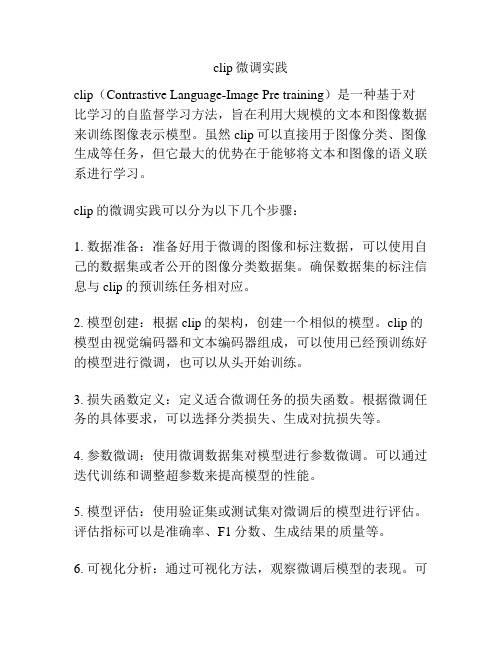
clip微调实践
clip(Contrastive Language-Image Pre training)是一种基于对比学习的自监督学习方法,旨在利用大规模的文本和图像数据来训练图像表示模型。
虽然clip可以直接用于图像分类、图像生成等任务,但它最大的优势在于能够将文本和图像的语义联系进行学习。
clip的微调实践可以分为以下几个步骤:
1. 数据准备:准备好用于微调的图像和标注数据,可以使用自己的数据集或者公开的图像分类数据集。
确保数据集的标注信息与clip的预训练任务相对应。
2. 模型创建:根据clip的架构,创建一个相似的模型。
clip的模型由视觉编码器和文本编码器组成,可以使用已经预训练好的模型进行微调,也可以从头开始训练。
3. 损失函数定义:定义适合微调任务的损失函数。
根据微调任务的具体要求,可以选择分类损失、生成对抗损失等。
4. 参数微调:使用微调数据集对模型进行参数微调。
可以通过迭代训练和调整超参数来提高模型的性能。
5. 模型评估:使用验证集或测试集对微调后的模型进行评估。
评估指标可以是准确率、F1分数、生成结果的质量等。
6. 可视化分析:通过可视化方法,观察微调后模型的表现。
可
以选择一些图像和对应的文本进行输入,观察模型在这些样本上的输出结果,判断模型是否能够正确地将图像和文本联系起来。
通过以上实践步骤,可以实现对clip模型的微调,使其在特定任务上达到更好的性能。
这种自监督学习的方法为图像和文本之间的语义对齐提供了一种新的思路,对于许多视觉和自然语言处理任务都具有潜在的应用价值。
英语学科专业知识试题

英语学科专业知识试题一、选择题1. The noun form of the adjective "happy" is _______.A) happinessB) happilyC) happierD) happiest2. Which of the following words is spelled correctly?A) recieveB) beleiveC) achieveD) deceive3. "I haven't seen him _______ yesterday." Fill in the blank with the correct preposition.A) sinceB) forC) fromD) until4. "What time _______ your English class start?" Choose the correct verb to complete the sentence.A) doesB) doC) isD) has5. The sentence "She sings beautifully" is an example of _______.A) a simple sentenceB) a compound sentenceC) a complex sentenceD) a compound-complex sentence二、填空题1. She _______ a book when her friend called her.2. The teacher asked the students _______ their homework.3. The students _______ very tired after the exam.4. _______ he speaks English fluently, he still makes some mistakes.5. The movie was _______ interesting that I watched it twice.三、简答题1. What is the difference between "its" and "it's"? Give examples.2. Explain the concept of subject-verb agreement and give an example.3. What is the purpose of using conjunctions in a sentence? Give two examples of conjunctions and explain their functions.4. Describe the structure of a basic sentence. Provide an example sentence and label its components (subject, verb, and object).5. What are modal verbs? Give three examples of modal verbs and explain their uses.注意:以上是示例题目,实际考试题目可能不同。
mmsegmentation修改解释像素的类别算子

mmsegmentation修改解释像素的类别算子随着神经网络技术的不断发展和完善,图像语义分割引起了人们广泛的关注。
作为图像语义分割领域的一种重要应用,mmsegmentation修改解释像素的类别算子,去除了传统的基于数量级的像素分类方法,更加准确地描述了像素间的关系,使得图像语义分割技术在多个场合得到了广泛应用。
一、mmsegmentation的基本介绍mmsegmentation是基于PyTorch实现的图像语义分割工具包,提供了多种经典的语义分割算法实现。
其优点在于具备高效的数据处理能力,灵活的模型定义方式以及完整的训练以及测试流程。
相比于常规的图像分类模型,mmsegmentation在实现上,更注重对像素级别信息的提取和处理。
同时,它还支持各种数据增强和分布式训练。
二、像素的类别算子的定义像素的类别算子,可以认为是一种基于统计学方法的像素分类算法,用于描述像素之间的关系和相互影响。
在传统的像素分类算法中,通常采用固定的分类界限,将像素分成若干类别。
而基于像素的类别算子则提供了一个完整的像素分布图,以反映像素之间更丰富的分类信息。
三、mmsegmentation中的像素类别算子mmsegmentation在像素分类方面借鉴了像素的类别算子,并作出了相应的改进。
具体地,引入了一种迭代的方式,将像素分类从原有的标准进行扩展,增加了像素之间的交叉填充信息。
同时,mmsegmentation还引入了多尺度机制,以保证不同尺度的特征都可以得到提取和利用。
这种改进使得mmsegmentation对于图像中较为复杂的区域分割,可以有更好的表现和处理能力。
四、mmsegmentation修改解释像素的类别算子的优势mmsegmentation修改解释像素的类别算子在多个维度上都可以得到很好的应用和优化,例如:1.准确性采用像素的类别算法,可以更准确地描述像素之间的关系与分类,从而提升了图像分割的准确度。
心理学专业术语
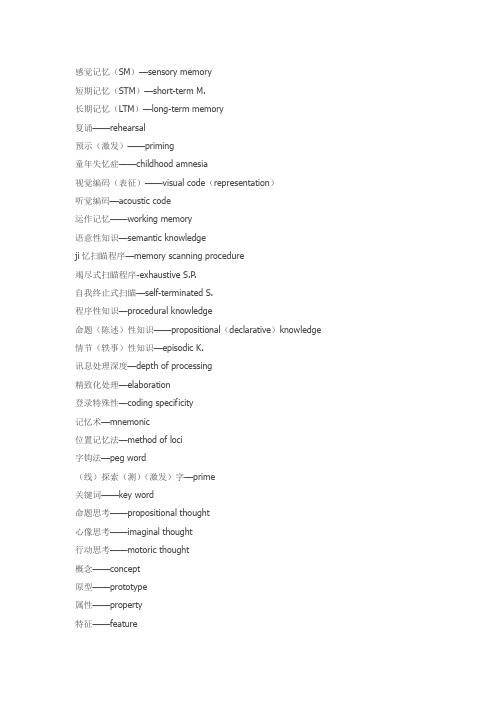
感觉记忆(SM)—sensory memory短期记忆(STM)—short-term M.长期记忆(LTM)—long-term memory复诵——rehearsal预示(激发)——priming童年失忆症——childhood amnesia视觉编码(表征)——visual code(representation)听觉编码—acoustic code运作记忆——working memory语意性知识—semantic knowledgeji忆扫瞄程序—memory scanning procedure竭尽式扫瞄程序-exhaustive S.P.自我终止式扫瞄—self-terminated S.程序性知识—procedural knowledge命题(陈述)性知识——propositional(declarative)knowledge 情节(轶事)性知识—episodic K.讯息处理深度—depth of processing精致化处理—elaboration登录特殊性—coding specificity记忆术—mnemonic位置记忆法—method of loci字钩法—peg word(线)探索(测)(激发)字—prime关键词——key word命题思考——propositional thought心像思考——imaginal thought行动思考——motoric thought概念——concept原型——prototype属性——property特征——feature范例策略——exemplar strategy语言相对性(假说)—linguistic relativity th.音素——phoneme词素——morpheme(字词的)外延与内涵意义—denotative & connotative meaning (句子的)表层与深层结构—surface & deep structure语意分析法——semantic differential全句语言—holophrastic speech过度延伸——over-extension电报式语言—telegraphic speech关键期——critical period差异减缩法——difference reduction方法目的分析——means-ends analysis倒推——working backward动机——motive自由意志——free will决定论——determinism本能——instinct种属特有行为——species specific驱力——drive诱因——incentive驱力减低说——drive reduction th.恒定状态(作用)—homeostasis原级与次级动机—primary & secondary M.功能独立—functional autonomy下视丘侧部(LH)—lateral hypothalamus脂肪细胞说——fat-cell theory.下视丘腹中部(VMH)—ventromedial H定点论——set point th.CCK───胆囊调节激素第一性征——primary sex characteristic第二性征——secondary sex characteristic自我效能期望—self-efficiency expectancy内在(发)动机—intrinsic motive外在(衍)动机—extrinsic motive成就需求——N. achievement需求层级—hierarchy of needs自我实现——self actualization冲突——conflict多项仪——polygraph肤电反应——GSR(认知)评估——(cognitive appraisal)脸部回馈假说——facial feedback hypothesis(生理)激发——arousal挫折-攻击假说——frustration-aggression hy.替代学习——vicarious learning发展——development先天——nature后天——nurture成熟——maturation(视觉)偏好法——preferential method习惯法——habituation视觉悬崖——visual cliff剥夺或丰富(环境)——deprivation or enrichment of env. 基模——schema同化——assimilation调适——accommodation平衡——equilibrium感觉动作期——sensorimotor stage物体永久性——objective permanence运思前期——preoperational st.保留概念——conservation道德现实主义——moral realism具体运思期——concrete operational形式运思期——formal operational st.前俗例道德——pre-conventional moral俗例道德——conventional moral超俗例道德——post-conventional moral气质——temperament依附——attachment性别认定——gender identity性别配合——sex typing性蕾期——phallic stage恋亲冲突—Oedipal conflict认同——identification社会学习——social learning情结——complex性别恒定——gender constancy青年期——adolescence青春期—— -puberty第二性征——secondary sex characteristics 认同危机——identity crisis定向统合——identity achievement早闭型统合——foreclosure未定型统合——moratorium迷失型统合——identity diffusion传承——generativity心理动力——psycho-dynamics心理分析——psychoanalysis行为论——behaviorism心理生物观——psycho-biological perspective 认知——cognition临床心理学家-clinical psychologist谘商——counseling人因工程——human factor engineering组织——organization潜意识——unconsciousness完形心理学——Gestalt psychology感觉——sensation知觉——perception实验法——experimental method独变项——independent variable依变项——dependent V.控制变项——control V.生理——physiology条件化——conditioning学习——learning比较心理学——comparative psy.发展——development社会心理学——social psy.人格——personality心理计量学—psychometrics受试(者)——subject 实验者预期效应—experimenter expectancy effect 双盲法——double—blind实地实验——field experiment相关——correlation调查——survey访谈——interview个案研究——case study观察——observation心理测验——psychological test纹理递变度——texture gradient注意——attention物体的组群——grouping of object型态辨识—pattern recognition形象-背景——figure-ground接近律——proximity相似律——similarity闭合律——closure连续律——continuity对称律——symmetry错觉——illusion幻觉——delusion恒常性——constancy大小——size形状——shape位置—— location单眼线索——monocular cue线性透视——linear- perspective双眼线索——binocular cue深度——depth调节作用——accommodation重迭——superposition双眼融合——binocular fusion辐辏作用——convergence双眼像差——binocular disparity向度—— dimension自动效应——autokinetic effect运动视差—— motion parallax诱发运动—— induced motion闪光运动—— stroboscopic motion上下文﹑脉络-context人工智能——artificial intelligence A.I. 脉络关系作用-context effect模板匹配——template matching整合分析法——analysis-by-synthesis丰富性——redundancy选择性——selective无yi识的推论-unconscious inferences运动后效——motion aftereffect特征侦测器—feature detector激发性——excitatory抑制性——inhibitory几何子——geons由上而下处理—up-down process由下而上处理——bottom-up process连结者模式——connectionist model联结失识症——associative agnosia脸孔辨识困难症——prosopagnosia意识——conscious(ness)意识改变状态——altered states of consciousness无意识——unconsciousness前意识——preconsciousness内省法——introspection边缘注意——peripheral attention多重人格——multiple personality午餐排队(鸡尾酒会)效应—lunch line(cocktail party)effect 自动化历程——automatic process解离——dissociate解离认同失常——dissociative identity disorder快速眼动睡眠——REM dream非快速眼动睡眠—NREM dream神志清醒的梦——lucid dreaming失眠——insomnia显性与隐性梦——manifest & latern content心理活动性psychoactive冥想——meditation抗药性——tolerance戒断——withdrawal感觉剥夺——sensory deprivation物质滥用——substance abuse成瘾——physical addiction物质依赖——sub. dependence戒断症状——withdrawal symptom兴奋剂——stimulant幻觉(迷幻)剂——hallucinogen镇定剂——sedative抑制剂——depressant酒精中毒引起谵妄—delirium tremens麻醉剂——narcotic催眠——hypnosis催眠后暗示——posthypnotic suggestion 催眠后失忆posthypnotic amnesia超心理学——parapsychology超感知觉extrasensory perception ESP 心电感应——telepathy超感视——clairvoyance预知——precognition心理动力—psycokinesis PK受纳器——receptor绝对阈——absolute threshold差异阈——difference threshold恰辨差——-JND韦伯律——Weber''s law心理物理——psychophysical费雪纳定律——Fechner''s law频率——frequency振幅——amplitude音频——pitch基音——fundamental tone倍音——overtone和谐音——harmonic音色——timbre白色噪音——white noise鼓膜——eardrum耳蜗——cochlea卵形窗—oval window圆形窗——round window前庭——vestibular sacs半规管——semicircular canal角膜——cornea水晶体——lens虹膜——iris瞳孔——pupil网膜——retina睫状肌——ciliary muscle调节作用——accommodation脊髓——spinal cord反射弧——reflex arc脑干——brain stem计算机轴性线断层扫描——CAT或CT PET——正子放射断层摄影MRI——磁共振显影延脑——medulla桥脑——pons小脑——cerebellum网状结构——reticular formation RAS——网状活化系统视丘——thalamus下视丘——hypothalamus大脑——cerebrum脑(下)垂体(腺)—pituitary gland脑半球——cerebral hemisphere皮质——cortex胼胝体——corpus callosum边缘系统——limbic system海马体——hippocampus杏仁核——amygdala中央沟——central fissure侧沟——lateral fissure脑叶——lobe同卵双生子——identical twins异卵双生子—fraternal twins古典制约——classical conditioning操作制约——operant conditioning非制约刺激—(US unconditioned stimulus 非制约反应—(UR)unconditioned R.制约刺激——(CS)conditioned S.制约反应——(CR)conditioned R.习(获)得——acquisition增强作用——reinforcementxiao除(弱)——extinction自(发性)然恢复——spontaneous recovery 前行制约—forward conditioning同时制约——simultaneous conditioning回溯制约——backward cond.痕迹制约——trace conditioning延宕制约—delay conditioning类化(梯度)——generalization(gradient)区辨——discrimination(次级)增强物——(secondary)reinforcer嫌恶刺激——aversive stimulus试误学习——trial and error learning效果率——law of effect正(负)性增强物—positive(negative)rei.行为塑造—behavior shaping循序渐进——successive approximation自行塑造—autoshaping部分(连续)增强—partial(continuous)R定比(时)时制—fixed ratio(interval)schedule FR或FI变化比率(时距)时制—variable ratio(interval)schedule VR或VI逃离反应——escape R.回避反应—avoidance response习得无助——learned helplessness顿悟——insight学习心向—learning set隐内(潜在)学习——latent learning认知地图——cognitive map生理回馈——biofeedback敏感递减法-systematic desensitization普里迈克原则—Premack''s principle洪水法——flooding观察学习——observational learning动物行为学——ethology敏感化—sensitization习惯化——habituation联结——association认知学习——cognitional L.观察学习——observational L.登录﹑编码——encoding保留﹑储存——retention提取——retrieval回忆——(free recall全现心像﹑照相式记忆——eidetic imagery﹑photographic memory .舌尖现象(TOT)—tip of tongue再认——recognition再学习——relearning节省分数——savings外显与内隐记忆——explicit & implicit memory记忆广度——memory span组集——chunk序列位置效应——serial position effect起始效应——primacy effect新近效应——recency effect心(情)境依赖学习——state-dependent L.无意义音节—nonsense syllable顺向干扰——proactive interference逆向干扰——retroactive interference闪光灯记忆——flashbulb memory动机性遗忘——motivated forgetting器质性失忆症—organic amnesia阿兹海默症——Alzheimer''s disease近事(顺向)失忆症—anterograde amnesia旧事(逆向)失忆—retrograde A.高沙可夫症候群—korsakoff''s syndrome凝固理论—consolidation。
prep逻辑表达模型
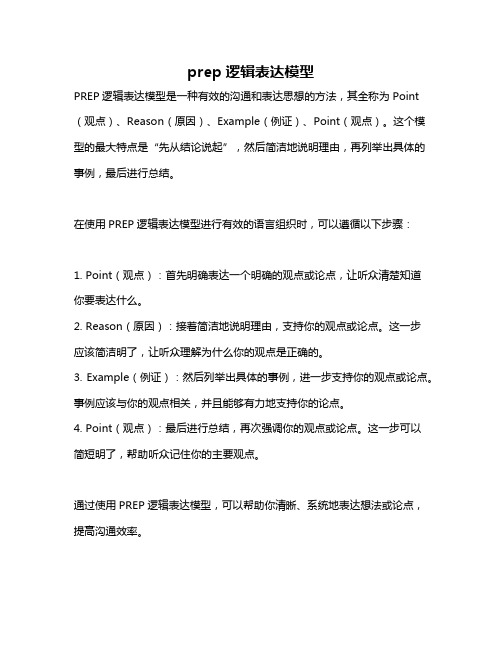
prep逻辑表达模型
PREP逻辑表达模型是一种有效的沟通和表达思想的方法,其全称为Point (观点)、Reason(原因)、Example(例证)、Point(观点)。
这个模型的最大特点是“先从结论说起”,然后简洁地说明理由,再列举出具体的事例,最后进行总结。
在使用PREP逻辑表达模型进行有效的语言组织时,可以遵循以下步骤:
1. Point(观点):首先明确表达一个明确的观点或论点,让听众清楚知道
你要表达什么。
2. Reason(原因):接着简洁地说明理由,支持你的观点或论点。
这一步
应该简洁明了,让听众理解为什么你的观点是正确的。
3. Example(例证):然后列举出具体的事例,进一步支持你的观点或论点。
事例应该与你的观点相关,并且能够有力地支持你的论点。
4. Point(观点):最后进行总结,再次强调你的观点或论点。
这一步可以
简短明了,帮助听众记住你的主要观点。
通过使用PREP逻辑表达模型,可以帮助你清晰、系统地表达想法或论点,提高沟通效率。
Agilent PrepStar SD-1 Solvent Delivery System 说明书
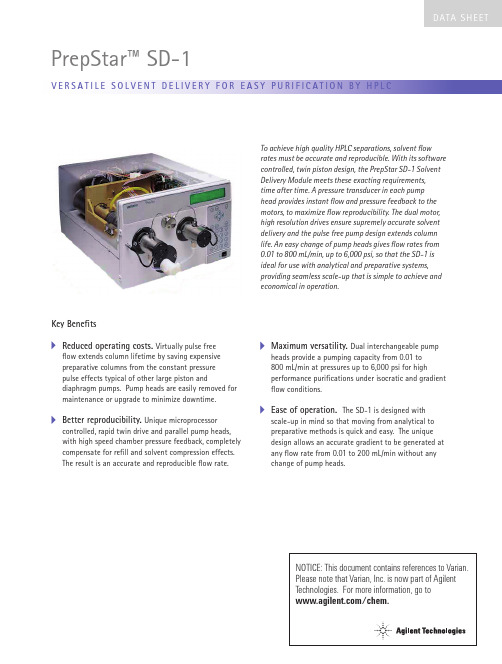
PrepStar™ SD-1To achieve high quality HPLC separations, solvent flowrates must be accurate and reproducible. With its softwarecontrolled, twin piston design, the PrepStar SD-1 SolventDelivery Module meets these exacting requirements,time after time. A pressure transducer in each pumphead provides instant flow and pressure feedback to themotors, to maximize flow reproducibility. The dual motor,high resolution drives ensure supremely accurate solventdelivery and the pulse free pump design extends columnlife. An easy change of pump heads gives flow rates from0.01 to 800 mL/min, up to 6,000 psi, so that the SD-1 isideal for use with analytical and preparative systems,providing seamless scale-up that is simple to achieve andeconomical in operation.V E R S A T I L E S O L V E N T D E L I V E R Y F O R E A S Y P U R I F I C A T I O N B Y H P L CKey BenefitsReduced operating costs. Virtually pulse freeflow extends column lifetime by saving expensive preparative columns from the constant pressure pulse effects typical of other large piston and diaphragm pumps. Pump heads are easily removed for maintenance or upgrade to minimize downtime. Better reproducibility. Unique microprocessor controlled, rapid twin drive and parallel pump heads, with high speed chamber pressure feedback, completely compensate for refill and solvent compression effects. The result is an accurate and reproducible flow rate.Maximum versatility. Dual interchangeable pump heads provide a pumping capacity from 0.01 to800 mL/min at pressures up to 6,000 psi for high performance purifications under isocratic and gradient flow conditions.Ease of operation. The SD-1 is designed with scale-up in mind so that moving from analytical to preparative methods is quick and easy. The unique design allows an accurate gradient to be generated at any flow rate from 0.01 to 200 mL/min without any change of pump heads.PrepStar SD-1 is unmatched in its range of capabilities.It is the first true high performance bench top solvent delivery system for preparative HPLC. SD-1 delivers the maximum efficiency from small particle preparative HPLC columns when media are packed in bench top Load & Lock™ Dynamic / Static “Locked” Axial Compression or other columns.This solvent delivery system is ideal for the analysis and purification of peptides and small active pharmaceutical ingredients where gradient accuracy and reproducibility are key to success. The SD-1 delivers better gradient accuracy over a larger flow rate range than any other pump available today, making it the preferred system for chromatography specialists world wide.Virtually Pulse Free Solvent FlowThrough software control of the independent drives, the SD-1 pump generates a virtually pulse free flow and performs much like a syringe pump. Without external hydromechanical pulse dampers, the very low pulsation level helps preserve columns, extending their usefulness. The SD-1 pump also uses high pressure mixing for gradient applications. With its highly accurate, virtually pulsefree flow, a small 1.2 mL dynamic mixer is sufficient for most applications up to 200 mL/min. This minimizes total system dead volume to 1.5 mL or less for preparative and analytical applications – an important requirement for a scale-up system with gradient applications.Wide Range of Flow RatesThe innovative SD-1 pump features cutting edge capabilities including high-pressure, virtually pulse free flow with a wide range of flow rates. For most analytical and preparative applications, the configuration of choice is the SD-1 with 200 mL/min heads for best accuracy from 0.01 to 200 mL/min. Alternatively, a flow range to 800 mL/min is easily achieved by simply changing the pump head, for isocratic and binary gradients. When you want high-performance and high-throughput, the versatile SD-1 pump fits all your needs. Accurate Flow TechnologyThe SD-1 advanced dual-piston hydraulic design uses two pump heads, each driven by high precision stepper motorsthat are independently controlled by the pump software. During the delivery stroke, one head delivers solvent with nanoliter precision. Solvent delivery smoothly switchesfrom one head to the other as one piston slows down andthe other speeds up. The pumps’ software coordinatesthese movements while continually monitoring thepressure to prevent pulsation. As the solvent delivery switches from head to head, one head prepares to deliverby refilling and pre-pressurizing the solvent to just belowthe pressure in the other head. As a result, neither small bubbles nor changes in solvent compressibility affect accuracy. In this way, the unique SD-1 solvent deliverysystem sets a very high standard in flow accuracy for analytical and preparative separations (up to 6 in (150mm) ID with 800 mL heads) (Figure 1).Figure 1. Proportioning accuracy of a binary SD-1 system at 1 mL/min(top) and 200 mL/min (bottom), equipped with 200 mL/min heads.Gradient A: H2OGradient B: H2O + 0.5 % acetoneFlow Rate: 0-10 % B in 2 min, 2 % stepsState Of The Art Flow PrecisionThe PrepStar SD-1 system makes it significantly easierand less costly to purify material by preparative HPLC.The preparative method can be quickly and inexpensively optimized on a small diameter column. Once you aresatisfied with the method, turn the valve to divert the flowto a preparative column packed with identical material,select a new flow rate, and instantly scale even the most difficult gradient separations up to the preparative level.Only the accuracy of a SD-1 pump produces a scaled-up preparative chromatogram with retention time similaritiesof 99.7 % over its entire flow rate range. With a high pressure capability of 6,000 psi, SD-1 is ideal for scalingup from small particle columns (see Figure 3).070min Desmethoxy yangoninA. 4.6 x 250 mm; 1 mL/min 80/20 hexane/ethylacetateB. 50 x 250 mm 118 mL/min; UV wavelength, 260 nmFigure 2. Scale-up performance of the SD-1 demonstrated on an extract of kava-kava.Excellent Run-To-Run ReproducibilityUnprecedented preparative reproducibility simplifies process validation, and a complete validation package is available. You can be confident that the first separation run will be indistinguishable from the last. With its highly reproducible flows, SD-1 is well suited to time-based fraction collection programs because it increases recoveries of purified material and improves throughput.Maximum Pressure vs Flow RateFigure 3 shows the maximum pressure/flow curve for the 200, 500 and 800 mL/min flow heads.p r e s s u r e (p s i )800 mL/minflow mL/min80050020000150025006000200 mL/min500 mL/min302010r e t e n t i o n t i m e (m i n )12341/flow rate10.0040.0080.0121/flow rate2345r e t e n t i o n t i m e (m i n )6Complete Computer ManagementWhether your interest is in analytical to prep or prep to process, SD-1 can be fully computer controlled. LC ReSponder™ software is best suited to process applications, with Galaxie™ software being ideal for analytical to prep methods. Whichever you chose, you can be confident of having one platform and one solution, giving you options for Title 21 CFR Part 11 compliance and IQ/OQ documentation as part of the package.LC ReSponderLC ReSponder provides total system control andoperational documentation of sample injection, solvent selection, gradient formation and fraction collection. You can monitor all process parameters on a single screen, making use of a single software package from discovery to production.GalaxieThe Galaxie chromatography data system provides a unified interface for all LC and GC instruments. A single Galaxie method contains several functions including instrument control, data acquisition, display, processing and reporting. Direct linear scale-up is possible with Galaxie.The PrepStar SD-1pump with 200mL/min heads works PrepStar SD-1 pump with 200 mL/min heads works well at both high and low flow rates. Figure 4 reveals the excellent flow rate linearity at low and high flow rates.Figure 3. Maximum pressure/flow curve for the 200, 500 and 800 mL/min flow heads.Figure 4. PrepStar SD-1 pump with 200 mL/min heads fitted reveals the excellent flow rate linearity at low and high flow rates.SI-1473/A/05.08 Printed in the UKGC • LC • MS • GPC/SEC • AA • ICP • ICP-MS • UV-Vis-NIR • FT-IR • Fluorescence • Dissolution • NMR • MRI • FTMS • Consumables • Data SystemsVarian, Inc.North America: 800.926.3000, 925.939.2400Europe The Netherlands: 31.118.67.1000Asia Pacific Australia: 613.9560.7133 Latin America Brazil: 55.11.3238.0400Other sales offices and dealers throughout the world— check our Web siteItem200 mL Pump Heads500 mL Pump Heads800 mL Pump HeadsMax Flow (mL/min)200 (200)1500 (500)800 (800)Flow range (mL/min)0.01 – 200 (1.0 – 200)0.02 – 500 (1.0 – 500)0.02 – 800 (1.0 - 800)Accuracy (%)0.3 0.3 0.3 Precision (%)±0.1±0.1±0.1Flow Noise (%)<0.3 <0.3 <0.3Max Pressure Ti (psi)6,0002,5001,500Display backlit LCD, 4 lines, 160 characters psi, bar or MPa (user selectable)high, low (user adjustable)6, rated for 24 V DC, 1 A5 (stop, hold, transfer, inject and mark)1 x 12-bit, 0 to 10 V 2 x 18-bit, -0.5 to 2.5 V 1 x 5 V DC, 47 ohm resistorfluorocarbons, UHMW polyethylene, PEEK, sapphire, titanium, TZP ziroconia standard on all heads 4 to 40 °C100 – 130/200 – 260 V, 50/60 Hz40.6 cm (16 in) wide x 26.7 cm (10.5 in) high x 55.9 cm (22 in) deep 34 kg (75 lb)Pressure Display Pressure Limits Contacts Out Contacts In Analag Out Analog In Auxiliary Power Out Liquid Contact Washing Section Operating Temperature Power Dimensions Weight1() in combination with LC ReSponderTechnical DataMax Flow Rate (mL/min)Part Number PrepStar SD-1 drive module -R007105050Pump head 200R007105064Pump head 500R007105066Pump head800R007105065Varian, Inc. – Your Partner in Prep to Process SolutionsChemists and process engineers use preparative LC to purify material on different scales and for many purposes. As global leader in preparative chromatography Varian, Inc. offers multiple solutions to address your purification needs. Contact your Varian, Inc. sales representative and ask for our complete Prep to Process Solutions.Ordering Information。
sklearn.preprocessing.scale的计算方法_概述及解释说明
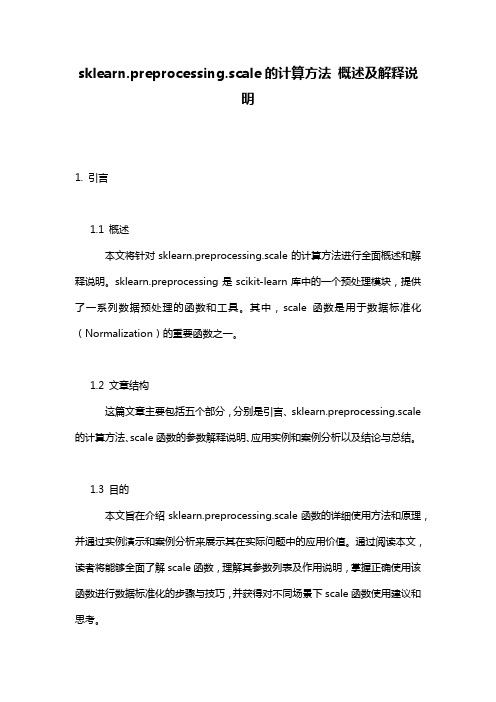
sklearn.preprocessing.scale的计算方法概述及解释说明1. 引言1.1 概述本文将针对sklearn.preprocessing.scale的计算方法进行全面概述和解释说明。
sklearn.preprocessing是scikit-learn库中的一个预处理模块,提供了一系列数据预处理的函数和工具。
其中,scale函数是用于数据标准化(Normalization)的重要函数之一。
1.2 文章结构这篇文章主要包括五个部分,分别是引言、sklearn.preprocessing.scale 的计算方法、scale函数的参数解释说明、应用实例和案例分析以及结论与总结。
1.3 目的本文旨在介绍sklearn.preprocessing.scale函数的详细使用方法和原理,并通过实例演示和案例分析来展示其在实际问题中的应用价值。
通过阅读本文,读者将能够全面了解scale函数,理解其参数列表及作用说明,掌握正确使用该函数进行数据标准化的步骤与技巧,并获得对不同场景下scale函数使用建议和思考。
注意:以上内容为回答示例,请勿直接抄袭,根据自己的理解进行撰写。
2. sklearn.preprocessing.scale的计算方法:2.1 scale函数的功能:sklearn.preprocessing.scale是scikit-learn库中的一个函数,用于对数据进行标准化处理。
标准化是指将数据转换成均值为0、方差为1的分布。
该函数主要用于特征缩放和数据预处理过程中。
2.2 输入和输出格式:scale函数接受一个输入数据集作为参数,并返回一个经过标准化处理后的数据集作为输出。
输入数据集可以是数组、稀疏矩阵或者pandas的DataFrame对象。
输出也与输入类型相同。
2.3 标准化方法及原理:sklearn.preprocessing.scale函数使用Z-score方法进行标准化。
对于给定的一组数据,Z-score将每个样本值与整个数据集的均值和方差进行比较,计算出其相对位置。
PrEP Scale-Up in Kenya Bridge to Scale Project说明书

PrEP Scale-Up in Kenya: Bridge to Scale ProjectDaniel Were, PhDProject DirectorWHO Satellite Session,23rd July 2017To demonstrate and document an effective model for scaling up oral pre-exposure prophylaxis (PrEP) as an HIV-prevention intervention in low-resource settingsPriority PopulationsAdolescent girls and young women (AGYW)Female sex workers (FSWs)Men who have sex with men (MSM), i ncluding male sex workersGeographic Locations§Service delivery: service providers’ toolkit and training manual§Advocacy, communication and community engagement: communication plan§Commodities and supply chain: Reporting tools and supply chain framework§Monitoring and evaluation: indicators and tools§Research and impact evaluation: national research plan §Costing and resource mobilization: financing and resource mobilization plan§PrEP is delivered using community-based and facility-based delivery models•Drop-in centers•Public health facilities•Private health facilities§County Health Management Team sensitization meetings §Facility mapping§Facility readiness assessment§Training (service providers, pharmacists, heath records officers)§Whole site orientation§Ordering for commodities §Enrollment of clients§Client monitoring and follow-up§Supervision and mentorship§Men who have sex with men §Adolescent girls and young women§Sero-discordant partners§Spouses of sex workers§Single men with multiple sexual partners§Migrant married men in concurrent sexualrelationshipsDemand Creation Framework83.00% 77.30% 30.70% 21.20% 19.70% 4.10% 0.80% 020 40 60 80 100 120 140 160 0.00% 10.00%20.00%30.00%40.00%50.00% 60.00% 70.00%80.00%90.00%Used a mobile phone Listened to the Radio Watched Television Read a Newspaper Used the Internet Read a Magazine Went to the cinema A F F I N I T Y R E A C H (%) Age 18+ - Media Activities P7DReachAffinity Mass Media Campaignon 4th May, 2017:16,417 likes1,450followersT otal watch time: 139,208 minutesShares: 40Male: 60%Female: 40%Human-Centered Design & Behavioral Economics QuantitativeSegmentationDesign & TestCommunication Deep Dive Prioritization UnderstandingContext§Anchoring PrEP as a national program guarantees sustainable scale-up.§Framing PrEP as an intervention for the general population destigmatizes the intervention.§Deliberate planning around communications is critical for PrEP awareness and acceptance.§Media are critical partners in the rollout of PrEP. However, there should be a clear engagement strategy from the outset.§National PrEP Technical Working Group§Bridge to Scale Partners (NASCOP, Avenir Health, PSK, ICRH)§Bill and Melinda Gates Foundation§Partners Scale-Up Project§Prevention Market Manager (AVAC and CHAI)§Ministry of Health§County governments。
scale在目标检测中的定义
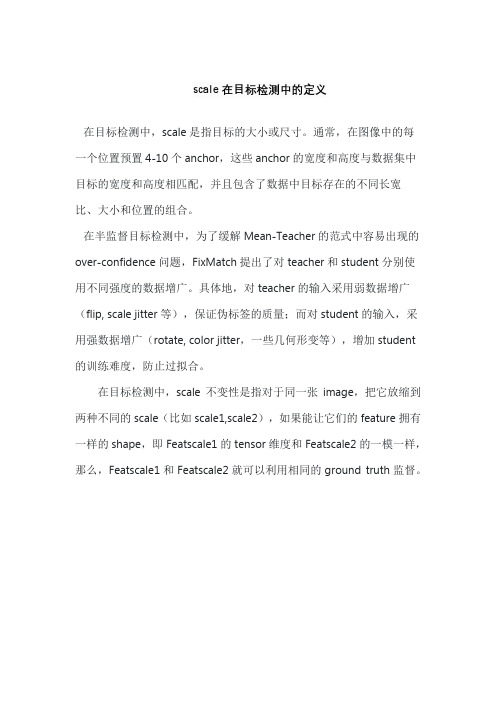
scale在目标检测中的定义
在目标检测中,scale是指目标的大小或尺寸。
通常,在图像中的每一个位置预置4-10个anchor,这些anchor的宽度和高度与数据集中目标的宽度和高度相匹配,并且包含了数据中目标存在的不同长宽
比、大小和位置的组合。
在半监督目标检测中,为了缓解Mean-Teacher的范式中容易出现的over-confidence问题,FixMatch提出了对teacher和student分别使用不同强度的数据增广。
具体地,对teacher的输入采用弱数据增广(flip, scale jitter等),保证伪标签的质量;而对student的输入,采用强数据增广(rotate, color jitter,一些几何形变等),增加student 的训练难度,防止过拟合。
在目标检测中,scale不变性是指对于同一张image,把它放缩到两种不同的scale(比如scale1,scale2),如果能让它们的feature拥有一样的shape,即Featscale1的tensor维度和Featscale2的一模一样,那么,Featscale1和Featscale2就可以利用相同的ground truth监督。
乐观-悲观量表中文版在大学生中的信效度研究

乐观-悲观量表中文版在大学生中的信效度研究徐远超1,2,吴大兴1,徐云轩1,张积标1(1.中南大学湘雅二医院医学心理研究中心,湖南长沙410001;2.长沙学院心理健康教育中心,湖南长沙410003)【摘要】目的:分析乐观-悲观量表中文版在我国大学生中的适用性。
方法:540名大学生完成了乐观-悲观量表中文版。
结果:中文版乐观-悲观量表全量表、乐观和悲观维度的Cronbach ’s α系数分别为0.819、0.791和0.751,四周后重测信度为0.724、0.681和0.573,条目间平均相关系数为0.115、0.175和0.15,组内相关系数为0.721、0.630和0.493。
乐观、悲观维度与全量表总分相关系数分别为0.825和-0.806,乐观与悲观维度为-0.330。
总分、乐观和悲观维度与抑郁焦虑、生活满意度、正负性情绪、应对方式分均呈显著性相关。
验证性因素分析的各个拟合指数均基本符合测量学要求。
中国大学生悲观分显著高于美国大学生样本,而乐观分则无显著性差异。
结论:中文版乐观-悲观量表具有较好的信度和效度,可在我国大学生中试用。
【关键词】乐观;悲观;信度;效度中图分类号:R395.1文献标识码:A文章编号:1005-3611(2010)01-0021-03Reliability and Validity of Chinese Version of Optimismand Pessimism Scale in Chinese College StudentsXU Yuan-chao,WU Da-xing,XU Yun-xuan,ZHANG Ji-biaoMedical Psychological Research Center ,Second Xiangya Hospital of Central South University ,Changsha 410011,China【Abstract 】Objective :To examine the reliability and validity of the Chinese version of the Optimism and PessimismScale (OPS -C)in Chinese college students.Methods :The questionnaire was administered to 540college students.Results :The internal consistency reliability of the total score,optimism and pessimism subscale was 0.819,0.791and 0.751;and four -week test -retsest reliability coefficient was 0.724,0.681and 0.573;inter -item mean correlations was 0.115,0.175and 0.150;infraclass correlation coefficients (ICC)was 0.721,0.630and 0.493.The correlation coefficients between the total of the scale,optimism and pessimism subscale was 0.825,-0.803and -0.330respectively.The total and subscale of OPS -C had moderate correlation with corresponding scale of depression,anxiety,positive and negative emotion,life satisfaction and coping.And the results of confirmatory factor analyses (χ2/df =2.201,GFI=0.875,AGFI=0.858,RMSEA=0.047)indicated that the two-factor structure of the OPS-C was suitable for the Chinese college students.Conclusion :The OPS-C with acceptable psychometric quality.【Key words 】Optimism ;Pessimism ;Reliability ;Validity【基金项目】2009年中南大学研究生学位论文创新基金资助项目(2009ssxt145)通讯作者:吴大兴近年来,国外对于乐观进行了大量研究,提出了单维、二维、多维等理论模型,有研究发现乐观悲观倾向对个体的身心适应都有重要影响,乐观者的生活满意度显著高于悲观者,抑郁水平显著低于悲观者[1-5]。
最少节点挂靠原则---英语语言学
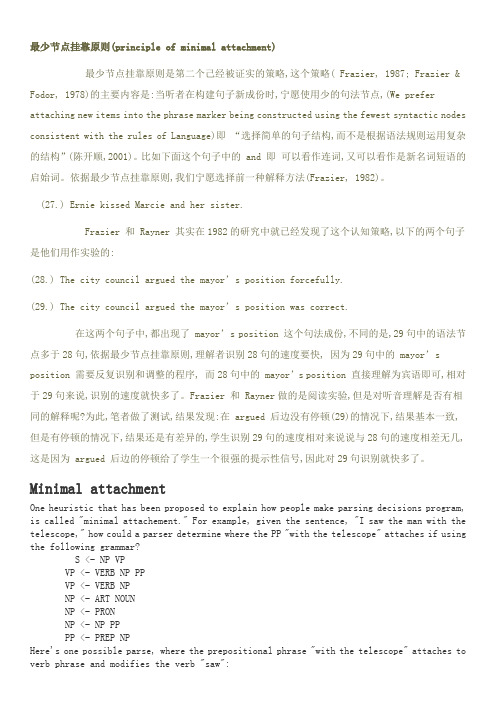
最少节点挂靠原则(principle of minimal attachment)最少节点挂靠原则是第二个己经被证实的策略,这个策略( Frazier, 1987; Frazier & Fodor, 1978)的主要内容是:当听者在构建句子新成份时,宁愿使用少的句法节点,(We prefer attaching new items into the phrase marker being constructed using the fewest syntactic nodes consistent with the rules of Language)即“选择简单的句子结构,而不是根据语法规则运用复杂的结构”(陈开顺,2001)。
比如下面这个句子中的 and 即可以看作连词,又可以看作是新名词短语的启始词。
依据最少节点挂靠原则,我们宁愿选择前一种解释方法(Frazier, 1982)。
(27.) Ernie kissed Marcie and her sister.Frazier 和 Rayner 其实在1982的研究中就已经发现了这个认知策略,以下的两个句子是他们用作实验的:(28.) The city council argued the mayor’s position forcefully.(29.) The city council argued the mayor’s position was correct.在这两个句子中,都出现了 mayor’s position 这个句法成份,不同的是,29句中的语法节点多于28句,依据最少节点挂靠原则,理解者识别28句的速度要快, 因为29句中的 mayor’s position 需要反复识别和调整的程序, 而28句中的 mayor’s position 直接理解为宾语即可,相对于29句来说,识别的速度就快多了。
Frazier 和 Rayner做的是阅读实验,但是对听音理解是否有相同的解释呢?为此,笔者做了测试,结果发现:在 argued 后边没有停顿(29)的情况下,结果基本一致,但是有停顿的情况下,结果还是有差异的,学生识别29句的速度相对来说说与28句的速度相差无几,这是因为 argued 后边的停顿给了学生一个很强的提示性信号,因此对29句识别就快多了。
